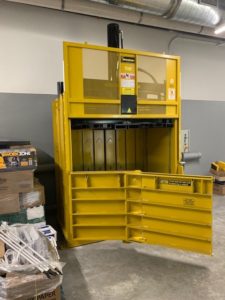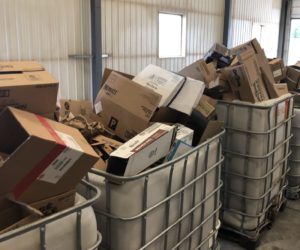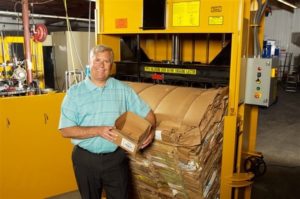Managing Cardboard In Supermarkets: Why More Grocers are Considering the Move to a 72″ Baler
Whether you manage a national chain, a smaller regional supermarket, or even a local hometown grocery store, everyone is looking for ways to efficiently manage cardboard waste, while generating additional recycling revenue.
The volume of cardboard generated, the frequency of inventory turnover, and overall product mix helps to determine which type of recycling baler should be used. Vertical down stroke balers, ranging in width from 30″-72″ are typically used for their ability to produce consistent dense bales while taking up minimal operational space.
Due to their lower price point and ability to make a mill-sized bale desirable for recycling, many retailers prefer a 60″ standard baler for OCC. There are many cases in which using a 60″ baler is the right application for grocery stores.
But, there are many reasons why grocers should consider a 72″ baler for their cardboard recycling. This is especially true, given the recent surge in consumer demand in supermarkets across the globe.
72″ balers tend to cost more. Quality 60″ balers run anywhere from $9,000-10,000, while 72″ balers can be as much as $19,000. But, hidden in that additional cost are several benefits for grocers who need to make larger bales faster. So, what makes the best grocery baler, especially for your business?
Reasons Why Grocers Should Consider A 72″ Baler For Cardboard

This M72HD baler was installed in a Florida supermarket to help them get the most out of their cardboard recycling with limited staff time needed.
Larger Loading Door – Most 72″ balers have a larger loading door or chamber opening for inserting boxes. The average 60″ baler door opening is 24″ x 60″ whereas 72″ balers average closer to 24″ x 72″. This important feature allows employees to load the baler without breaking the boxes down first. This reduces the time needed for employees to make a bale, allowing them to spend time on more important tasks inside the store.
Faster Cycle Times – Once the chamber is full, and a bale cycle is initiated, 72″ balers typically have a cycle time of less than 30 seconds. 60″ standard balers range from 45-52 seconds per cycle. If you are running the baler for multiple cycles, this is another huge gain in equipment and employee efficiency.
Ram Force – While most 60″ balers provide a ram force of around 50K lbs, 72″ balers are nearly double at 92,000 lbs of force. This means that the resulting bale is of a much higher density, and therefore weight, yielding a higher profit at the recycling center.
Motor and Cylinder – 72″ balers are simply more robust. In comparison to 60″ balers that might normally use a 5-10 HP Motor, 72″ balers use 15-20 HP Motors that last longer with heavy duty use, while providing the power needed to generate dense bales. In addition the size of cylinder used makes a big difference to the longevity of the machine. 60″ balers typically utilize 6″ cylinders, while 72″ balers use 7-8″ cylinders for longer life.
Weight of Bales Produced – 72″ balers can make bales in excess of 1,300 lbs! This is well over the industry standard of 1000-1,100 lb. bales made by 60″ balers.
Similar Operational Area – Although the overall width of a 72″ baler does require approximately one more foot of space, the lower overall height makes the entire operational space required for the baler very similar to a 60″ baler. An additional advantage to the lower overall height is the loading accessibility for any employee.
Total Efficiency – With all of these items combined, 72″ balers can achieve an astounding efficiency, baling over 2,000 lbs of virgin cardboard boxes (fully in tact) per hour.
Harmony’s President, Steve Cremer, has been a visionary on the front line of recycling for decades. Weighing in on the benefits of a 72” baler for the grocery industry, Steve states,
“Harmony Enterprises has been supplying 72” vertical balers to the market for over 35 years. It was design for grocery stores that only had a small footprint for a baler, but a big volume of larger cardboard boxes.
This baler has become the most efficient vertical baler we offer to this market. Its large front opening eliminates the need to cut down large boxes to fit into the baler and its 29-second cycle time large chamber allows it to bale over 2,000 lbs. of cardboard an hour.
It can ship upright on trailers and be installed without tipping its side to saving money on freight and installation.”
Make the Right Choice
This article isn’t intended to suggest that a 60″ baler is not right for your application. There are many instances in which these standard balers are exactly the right choice and provide the highest return on your investment.
However, buyers should also be aware of the differences between these two sizes of balers. Investing in a 72″ baler may provide the larger of returns on investment with substantial savings in efficiency and longevity, depending on use case.
For either baler, we suggest that you contact an industry professional that manufactures and sells their own equipment. They will be able to provide you with detailed specifications and engineering benefits for each model. In many instances, they will also be willing to offer free quotes and no-obligation site review or systems analysis to help you determine which size of baler is right for you. They will also have resources for maintenance and troubleshooting, as well as more expedient access to parts and accessories for your baler.
Harmony Enterprises, Inc.
Harmony Enterprises is a third-generation, family owned manufacturer of balers, compactors, and liquid extraction equipment. We have been in business since 1962 and work relentlessly to provide the lowest total cost of ownership with a true partnership approach. If you are interested in learning more about vertical balers for the grocery industry, or more specific information about which size of baler will help you maximize your recycling efforts, please contact us at [email protected] or visit us at www.harmony1.com today!


